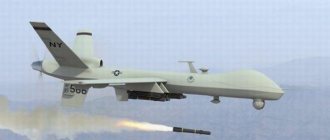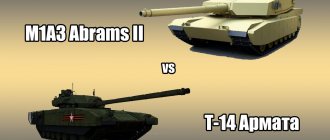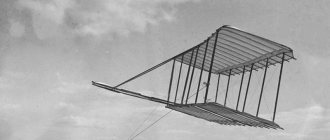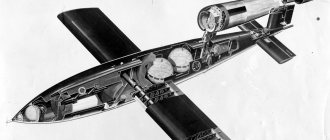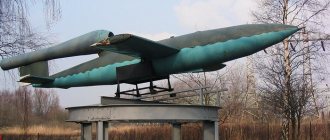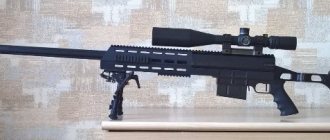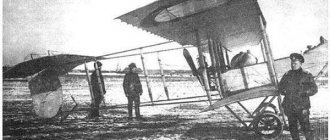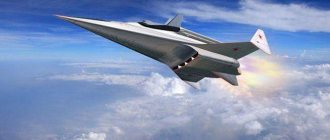The idea of creating a mobile command post in case of war is not new. The issue of creating the so-called MCP, or mobile command post, began to be worked out almost immediately after the end of World War II. However, the first experiments to create MCPs did not bring any serious results. Basically, the theme of a ground-based control and communications complex consisting of several trucks was considered as a working option.
Later, the idea was rejected: a potential enemy could detect the movement of a convoy of cars using reconnaissance and aviation means. The failed idea of the desire to create mobile ground control posts was picked up and turned into the right direction almost immediately, and in the early 60s, the first samples of aircraft converted to communicate with troops on the ground began to appear.
The beauty of the solution was that the constant presence of such aircraft in the sky excluded any unexpected attack from the enemy, and even the worst scenario in this case did not look hopeless. If, for one reason or another, all ground communications and communication lines could fail, then several aircraft, converted into an air command post, could ensure the transmission of orders and guarantee a retaliatory strike. According to the plan, the CPSU had to provide at least two important conditions. Firstly, to establish a stable channel of communication between the top officials of the state and the troops and the most important government structures, and secondly, to guarantee the inevitability of a strike even in the event of a full-scale nuclear war.
The first swallows
The first Soviet VKP - turboprop Il-22, built on the basis of civilian Il-18 - turned out to be universal. The aircraft was designed and equipped in such a way that with its help it was possible not only to activate the “nuclear flywheel”, but also to control troops in certain directions. A new generation of aircraft - the Il-86VKP - was also created taking into account long flights and was modified to operate in conditions of a full-scale war. A spacious Il-86 passenger aircraft was chosen to accommodate equipment, communications and personnel. Four engines, a length of two-thirds of a football field and a carrying capacity of 42 tons guaranteed the placement of the necessary equipment and comfortable work for special passengers.
Despite its peaceful base, the converted Il-86VKP was significantly different from its civilian counterpart. It will not be difficult to distinguish a special aircraft in the parking lot from civilian airliners, even if the aircraft is poorly lit or it is not possible to get close to it. A massive compartment for communications equipment, a kind of “hump” just behind the cockpit, is the calling card of the domestic “Doomsday plane”.
There are several similar containers for radio-electronic equipment that are not intended for installation in civilian ones, but all the main secrets of the flying General Staff are still inside. Despite the fact that access to such aircraft is closed to all outsiders, judging by the level of implementation of the idea, it can be argued that the IL-86VKP, in addition to powerful receiving and transmitting devices, is equipped with a full range of signal processing, encryption/decryption, a special communication channel (including satellite) and means electronic warfare to protect the aircraft from being hit by aircraft missiles.
Information about the composition of the IL-80 equipment is still classified - an unprecedented case in the history of aircraft manufacturing. And although the design, communication frequencies, number of people on duty at posts and airborne defense equipment are still closed, some devices of the air command post are worth talking about separately. Along with the management of the Ground, Aerospace Forces and other branches of the military, the nuclear triad is of particular value in the Russian Armed Forces - nuclear charges placed on land, aviation and sea carriers.
To communicate and exchange information with submarines operating covertly in all areas of the World Ocean, the Il-80 is equipped not only with a special communication channel, but also with a unique antenna mounted in the tail section. The length of the antenna deployed to its working position is eight kilometers and allows you to communicate with submarines at long ranges, and the submarines do not need to “move” to the surface position for a radio communication session.
Like any aircraft of strategic importance, the Il-86VKP air command posts have been repeatedly modernized - programs for upgrading and re-equipping the board with modern electronic equipment will allow the air command post to be kept in service until 2025. Looking ahead, it is worth noting that the Il-86VKP was not the only aircraft to provide communications at hour X.
Back in the USSR, the Il-76VKP aircraft was designed and built - a communications and command and control vehicle based on the Il-76 transport aircraft. And although the 76th is much smaller in size compared to its older brothers, in terms of the number of advanced technical solutions, the Il-76VKP is on par with other aircraft. Most of the components, assemblies, communication systems and the redesigned fuselage migrated to the Il-76VKP from another special purpose aircraft - the A-50 long-range radar detection and control aircraft (AWACS). As in the case of the “senior comrades,” the Il-76VKP from the 3rd Aviation Squadron differs from the passenger and transport aircraft in the units of equipment for special communications, as well as in a modified and modified fuselage.
Russia and the USA have doomsday planes: how and where they will fly in the event of the end of the world
What is a "Doomsday Plane"
Such aircraft can remain in flight for a whole week, subject to aerial refueling. All equipment on board is protected from the damaging factors of a nuclear explosion. Each machine is capable of lifting a hundred people into the air. It is always fully ready to fly within minutes.
The aircraft is equipped with equipment for receiving fuel from tanker aircraft. With periodic in-flight refueling, the aircraft can stay in the air for a week (possibly more).
Its service life in the air is limited only by the working life of the oil in the engine oil systems.
American Doomsday Planes
E-4B "Nightwatch" known as NEACP (National Emergency Airborne Command Post), pronounced [niːkæp], and since 1994 received the second name NAOC (National Airborne Operations Center) - airborne command posts (VKP).
E-4Bs are called "doomsday" or "doomsday" planes. They are intended for the President, Secretary of Defense and other members of the senior US military leadership in the event of a nuclear war if ground control structures are destroyed or damaged.
The aircraft received large workspaces, the area is 429.2 square meters.
As for the E-4, three E-4A and one E-4B were initially created: the first were then brought to the level of a later modification. The E-4B can be distinguished from the old version and, in general, from almost all other existing aircraft by its large fairing, where the satellite communication antennas are located.
If you believe data from open sources, the plane can stay in flight for a week - of course, provided that it is refueled. To fully refuel an E-4B in the air, two KC-135 tanker aircraft are needed.
In the conditions of a nuclear war, no one can guarantee even this, but if these conditions are met, then formally the time spent in the air is limited only by the service life of the oil in the engine oil systems. Also, all equipment on board is protected from the damaging factors of a nuclear explosion. However, depending on the situation, there may be 60-144 people on board.
American aircraft design
- Upper deck
The upper deck is located above the middle deck in the superstructure at the front of the fuselage, where the flight deck and upper cabin are located on conventional Boeing 747s.
Crew cabin and upper deck rest area
The flight deck includes workstations for the crew commander, co-pilot, navigator and flight engineer. Behind the flight deck there is a rest area and sleeping areas for the flight crew and other crew members.
- Middle deck
The middle deck is located on the site of the main passenger cabin of the Boeing 747.
Front zone
In the front area there is a kitchen, stairs to the upper deck, to the lower deck and to the forward technical area. There are refrigerators, freezers, food supplies, stoves and microwaves installed there, which make it possible to provide hot meals to all team members on long multi-day flights with in-flight refueling. On the left side of the front area there are four seats for stewards and security.
NCA zone
Following the front zone is the NCA (National Command Authority) zone, which serves for the work and rest of the President of the United States, the Secretary of Defense, or those who, if necessary, replace them according to the law. It includes a work area, a relaxation area, sleeping places, and a changing room. Telephone equipment allows you to establish reliable and secure communications using aircraft systems with any control structures and heads of other states.
Command Conference Room (NCA)
The command briefing room contains a conference table, three NCA chairs, eighteen additional chairs, a lectern, and two projection screens.
Communications and communication zone
The communications and communication zone is divided into voice and data zones. The voice communication area, located on the right, consists of workstations for a radio operator, a semi-automatic switchboard operator and a communications officer. The data transfer area is located on the left.
Aviation Equipment Zone
The aviation equipment area contains electrical equipment for powering aircraft systems, flight avionics, oxygen equipment, luggage and spare parts storage areas.
Meeting room and projection room
The meeting room is a secure area for secret meetings. It has a conference table and nine chairs. At the end of the briefing room there is a projection room that provides the display of computer graphics, 35 mm slides on screens in the briefing room and in the NCA room.
Operations team zone
Behind the projection room there is an “operations team” workstation area containing 29 workstations and data processing equipment. Workstations provide access to data, telephone and radio voice communication channels, direct (“hot”) communication lines, internal communications for operators and command. There is sound recording equipment.
Technical control zone
In the left front part of the control zone space there is a switchboard, SHF SATCOM satellite communication systems, and other equipment.
- Lower deck
Lower front technical area and lower rear technical area
In the lower front technical area there are water tanks, 1200 kVA electrical equipment, step-down transformers, ultra-low frequency transmitters, and SHF SATCOM space communications equipment. In the front part of the lower technical area on the right, near the outer doors, electric lifting ramps are installed for entering and exiting the aircraft to the ground.
The rear technical area contains an operator station and other equipment for communication with the Pentagon command post.
Towed antenna area
The towed antenna area contains a coil of an 8-kilometer towed ultra-long-wave antenna for communication with submarines, an operator's workplace with control devices for the release and retraction of the antenna and indication of the antenna status.
Russian and Soviet Doomsday Planes
The USSR had a large number of aircraft with similar functionality:
- IL-22,
- Il-22M-11,
- Il-22M-15 based on the Il-18 passenger aircraft.
In the 80s, serial production of the Il-86 aircraft was launched. It was he who became the basis for the main Russian air command post - the Il-80 aircraft, or Il-86VzPU. Over the entire period, four Il-80s and two Il-76SKs were built, which were supposed to solve similar problems.
Both cars can be immediately recognized by the characteristic “hump” where various electronic equipment is located. However, there is one important difference: the Il-76SK was created not on the basis of the Il-80, but on the basis of the transport Il-76. And this car is much smaller.
The IL-80 is conceptually close to the E-4 - and not only externally. Initially, the aircraft was developed to evacuate the country's top military leadership while maintaining the ability to simultaneously command the Armed Forces. This also applies to nuclear conflict. Of course, the car has everything necessary to make people on board feel safe. Unfortunately, it is impossible to announce the characteristics of the Il-80 and Il-76SK due to the secrecy that accompanies the aircraft from their very birth.
However, some details are publicly available. It is known, in particular, that the IL-80 should have a failure rate ten times lower than other military aircraft. We must assume that even if this is an exaggeration, it is not far from the truth.
Newest aircraft
- Russian
Russia is developing new airborne command posts, better known as “Doomsday” aircraft. They will be created on the basis of the Il-96-400M wide-body airliner, and subsequently at least two of these air launchers will become a replacement for the Il-80.
The project is called "Zveno-3S". The aircraft's radio system is designed to transmit orders to troops within a radius of 6 thousand kilometers; it will be able to communicate with strategic aviation, mobile and silo installations, and submarines.
Compared to its predecessor, the Il-80, the range of the new Il-96-400M, which represents a deep modernization of the Il-96-300, will double. Detailed characteristics of the Doomsday aircraft are a state secret.
An expert at the Russian Institute for Strategic Studies (RISI), Candidate of Political Sciences Andrei Gubin suggested that Russia needs new VZPUs because it meets the trends of the time. He also emphasized that in the modernized Il-96-400M all internal equipment will be domestic.
- American
In 2022, the Pentagon announced a competition to modernize the Boeing E-4B. As part of it, the on-board electronics must be updated.
The work covers: national and nuclear communications systems (N2CS) software/hardware support/upgrades, flight support facilities, technical support staffing, N2CS systems support and upgrades, design of N2CS systems and modifications.
Statement from the Pentagon press service
Starting in 2021, they plan to allocate up to $100 million annually for the modernization program.
Earlier, on July 26, the Pentagon shared footage of its air command post. US Department of Defense Headquarters Press Secretary John Kirby posted a video on Twitter showing an E-4B being refueled in midair.
An E-4B refuel mid-flight simply never gets old. My goodness, the skills it takes! Great flying by these aircrews. Thank you so much. pic.twitter.com/ZRxXPOd84O
— John Kirby (@PentagonPresSec) July 26, 2021
Read more:
Detailed photographs of the galaxies closest to us have appeared
For the first time in history, 9 stars disappeared in half an hour and did not return
Physicists have told what will happen if the Moon approaches the Earth
Strategic Siberian Crane
The third generation of “Doomsday planes” will differ slightly more than completely from its predecessors. According to a Life source, the Il-96-400T aircraft, a cargo modification of the Il-96-300, is used as the basis for the next generation air command post. The President and Supreme Commander-in-Chief of the Armed Forces of the Russian Federation, Vladimir Putin, flies on the same plane, Il-96-300PU.
The characteristics of the IL-96-400T already allow developers and manufacturers of radio-electronic equipment to fully use their own developments in the field of communications and secure channels for data transmission. Unlike the modernized Il-86VKP, the “Doomsday Plane”, built on the basis of the Il-96-400T, will be able to carry up to 92 tons of payload. And although the long-range aircraft was developed for commercial use, 92 tons of electronic equipment will ensure stable communications with all headquarters and military districts.
According to Life’s source in the defense industry, the fuel supply and the design of high-performance aircraft engines will allow the new “air fortress” to fly at a distance of up to 11 thousand kilometers. The third generation of VzPU, taking into account the solutions already introduced into industrial production, will be head and shoulders more effective than the IL-86VKP. Firstly, such a concept as “limited flight range” will practically disappear: the new special aircraft will be able to fly across the entire country without any problems.
Secondly, compared to the previous VzPU, the new aircraft based on the Il-96-400T is almost ten meters longer, which allows additional equipment or household items for the crew members to be placed on a free section of the fuselage. Thirdly, the modern element base, the production of which has already been established by enterprises of the Russian military-industrial complex, will make it possible to reduce the size and weight of special equipment for communications and data transmission by several orders of magnitude. Experts claim that in this regard, the new aircraft can be equipped with additional fuel tanks, with the use of which the non-stop flight range of the air command post will significantly increase and amount to 13 thousand kilometers instead of 11. It is also reported that, having absorbed all the experience of domestic science and modern electronics , a new aircraft based on the Il-96-400T will in the near future be able to replace all operating aircraft of this type.
Save yourself and respond
The specter of nuclear war has hovered over the world since 1945, when the United States dropped atomic bombs on Hiroshima and Nagasaki.
In the post-Soviet space, this action is often viewed as a demonstration of the “criminal intent of the United States.” But the Yankees did not seek to destroy the USSR, their ally in World War II, otherwise they would have done it long before it had an atomic bomb. Stalin actually did not see the real birth of the Soviet “miracle weapon”: this happened already under Nikita Khrushchev. The US territory could be reached by the initially problematic, but still adopted in 1960, two-stage intercontinental ballistic missile R-7, which has always attracted enormous interest overseas. Washington's worries were not in vain: attacks on the United States and the death of the country became a reality - as well as the destruction of military infrastructure, in particular command centers, as well as the death of the military and political leadership, of course.
The Soviet Union first tested its own atomic bomb, the RDS-1, on August 29, 1949. However, at that time it did not yet have a carrier that could effectively “work” across the United States. In turn, the West not only had advanced strategic bombers (the giant Convair B-36, for example), but also bases in Europe from which it could bomb the Land of the Soviets.
This is how the idea came to create a doomsday plane: a winged machine from which you can control an army and even an entire country. In theory, anyone could play her role, but this is in theory: you cannot be in the sky “forever.” And even just flying from point “A” to point “B” in wartime conditions can become a big problem. We had to create specialized machines.
R-7 is a two-stage intercontinental ballistic missile with a detachable warhead weighing 3 tons and a flight range of 8 thousand km. / ©wikipedia.org
American planes
The United States introduced the airborne command post (ACP) in 1962 by upgrading the KC-135A tanker, which in turn was an upgraded Boeing 707 passenger aircraft. The first modern (with some reservations) aircraft of this class was the Boeing E-4, now known as Nightwatch. As expected, the aircraft received large workspaces, which were equipped with the most advanced communications and information processing equipment. The working area of the E-4 is 429.2 square meters, which is approximately three times larger than that of the EC-135C aircraft, one of the VKP versions.
Boeing E-4 took to the skies on June 13, 1973. Here, however, we need to be clear: these machines should not be confused with presidential aircraft, which are also equipped with the latest technology and have the highest level of protection. The latter includes the modern American Boeing VC-25, or Air Force One. The US has built a total of two VC-25s since 1986.
As for the E-4, three E-4A and one E-4B were initially created: the first were then brought to the level of a later modification. The E-4B can be distinguished from the old version and, in general, from almost all other existing aircraft by its large fairing, where the satellite communication antennas are located.
Aircraft E-4B / ©CC0 / Masteruploader
The basis for the E-4A and E-4B was the well-known four-engine long-range double-deck wide-body passenger aircraft Boeing 747. It is worth saying that although the airliner made its first flight back in 1969 and has many accidents to its name, it is still considered one of the most reliable passenger aircraft in history. Sixty-three cars lost in accidents are not so many compared to the 1,500 produced over the years. This, of course, is not the top three in terms of safety, but it is quite a decent indicator.
What's so special about the E-4B itself? Firstly, the price. According to open sources, one such machine costs approximately 220-250 million dollars. Of course, it is far from the level of the B-2 strategic bomber with a price tag of two billion greenbacks. However, according to estimates, the Doomsday plane occupies a respectable second position. It is appropriate to recall that the fifth-generation fighters F-22 and F-35, after being launched into full-scale mass production (F-22, by the way, have already ceased production), have become much cheaper and have long ceased to cost as much as they did before.
The more interesting question concerns capabilities. Again, if you believe data from open sources, the plane can stay in flight for a week - of course, provided that it is refueled. To fully refuel an E-4B in the air, two KC-135 tanker aircraft are needed. In the conditions of a nuclear war, no one can guarantee even this, but if these conditions are met, then formally the time spent in the air is limited only by the service life of the oil in the engine oil systems. By the way, all equipment on board is protected from the damaging factors of a nuclear explosion. However, depending on the situation, there may be 60-144 people on board.
If we take a closer look at the aircraft, we will see that the E-4B has three decks: upper, middle and lower. The crew cabin is located on the upper deck. Behind it there is a recreation area, where, among other things, there are sleeping places for the flight crew and other crew members.
The middeck has another lounge area, technical control area, control area, workstation area, meeting room and projection room. There are also areas for aviation equipment, communications and communication, a command meeting room, a work and rest area for the US President, Secretary of Defense and other important persons. In addition, the middeck is a forward area with a galley, refrigerators, freezers, food supplies and much more that is needed to keep crew members working.
As for the lower deck, there is a towed antenna area, a lower rear technical area and a lower forward technical area. The towed antenna compartment contains a coil of an eight-kilometer towed ultra-long wave antenna, designed to be able to communicate with submarines in any situation. The technical areas contain space communications equipment, as well as many other equipment: for example, electric stairs for entering and exiting the aircraft.
Current state of the project
In the 80s, 4 aircraft were built. Now all IL-80s are located at the Chkalovsky airfield. Since the equipment is in service, there is little information on it. It is known that 1 or 2 aircraft were modernized with more modern electronic equipment. The new IL 80 uses advanced digital communications systems from new weapons. Aviation itself has changed little over the past 30 years, so only the electronic part is being modernized.
